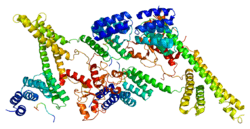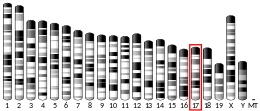STUB1
STUB1 (STIP1 homology and U-Box containing protein 1) is a human gene that codes for the protein CHIP (C terminus of HSC70-Interacting Protein).[5][6]
Function
The CHIP protein encoded by this gene binds to and inhibits the ATPase activity of the chaperone proteins HSC70 and HSP70 and blocks the forward reaction of the HSC70-HSP70 substrate-binding cycle.[6] In addition, CHIP possesses E3 ubiquitin ligase activity and promotes ubiquitylation[7], mainly of chaperone-bound misfolded proteins.
CHIP enhances HSP70 induction during acute stress and also mediates its turnover during the stress recovery process. Hence CHIP appears to maintain protein homeostasis by controlling chaperone levels during stress and recovery.[8]
Mutations in STUB1 cause spinocerebellarataxiatype 16.[9]
Interactions
STUB1 has been shown to interact with:
References
- GRCh38: Ensembl release 89: ENSG00000103266 - Ensembl, May 2017
- GRCm38: Ensembl release 89: ENSMUSG00000039615 - Ensembl, May 2017
- "Human PubMed Reference:". National Center for Biotechnology Information, U.S. National Library of Medicine.
- "Mouse PubMed Reference:". National Center for Biotechnology Information, U.S. National Library of Medicine.
- "Entrez Gene: STUB1 STIP1 homology and U-box containing protein 1".
- Ballinger CA, Connell P, Wu Y, Hu Z, Thompson LJ, Yin LY, Patterson C (Jun 1999). "Identification of CHIP, a novel tetratricopeptide repeat-containing protein that interacts with heat shock proteins and negatively regulates chaperone functions". Molecular and Cellular Biology. 19 (6): 4535–45. doi:10.1128/mcb.19.6.4535. PMC 104411. PMID 10330192.
- Jiang J, Ballinger CA, Wu Y, Dai Q, Cyr DM, Höhfeld J, Patterson C (Nov 2001). "CHIP is a U-box-dependent E3 ubiquitin ligase: identification of Hsc70 as a target for ubiquitylation". The Journal of Biological Chemistry. 276 (46): 42938–44. doi:10.1074/jbc.M101968200. PMID 11557750.
- Qian SB, McDonough H, Boellmann F, Cyr DM, Patterson C (Mar 2006). "CHIP-mediated stress recovery by sequential ubiquitination of substrates and Hsp70". Nature. 440 (7083): 551–5. doi:10.1038/nature04600. PMC 4112096. PMID 16554822.
- Synofzik M, Schüle R, Schulze M, Gburek-Augustat J, Schweizer R, Schirmacher A, Krägeloh-Mann I, Gonzalez M, Young P, Züchner S, Schöls L, Bauer P (2014). "Phenotype and frequency of STUB1 mutations: next-generation screenings in Caucasian ataxia and spastic paraplegia cohorts". Orphanet Journal of Rare Diseases. 9 (1): 57. doi:10.1186/1750-1172-9-57. PMC 4021831. PMID 24742043.
- Dogan T, Harms GS, Hekman M, Karreman C, Oberoi TK, Alnemri ES, Rapp UR, Rajalingam K (Dec 2008). "X-linked and cellular IAPs modulate the stability of C-RAF kinase and cell motility". Nature Cell Biology. 10 (12): 1447–55. doi:10.1038/ncb1804. PMID 19011619.
- Imai Y, Soda M, Hatakeyama S, Akagi T, Hashikawa T, Nakayama KI, Takahashi R (Jul 2002). "CHIP is associated with Parkin, a gene responsible for familial Parkinson's disease, and enhances its ubiquitin ligase activity". Molecular Cell. 10 (1): 55–67. doi:10.1016/s1097-2765(02)00583-x. PMID 12150907.
- Li X, Huang M, Zheng H, Wang Y, Ren F, Shang Y, Zhai Y, Irwin DM, Shi Y, Chen D, Chang Z (Jun 2008). "CHIP promotes Runx2 degradation and negatively regulates osteoblast differentiation". The Journal of Cell Biology. 181 (6): 959–72. doi:10.1083/jcb.200711044. PMC 2426947. PMID 18541707.
Further reading
- Patterson C (Jan 2002). "A new gun in town: the U box is a ubiquitin ligase domain". Science's STKE. 2002 (116): pe4. doi:10.1126/stke.2002.116.pe4. PMID 11805346.
- Scanlan MJ, Chen YT, Williamson B, Gure AO, Stockert E, Gordan JD, Türeci O, Sahin U, Pfreundschuh M, Old LJ (May 1998). "Characterization of human colon cancer antigens recognized by autologous antibodies". International Journal of Cancer. 76 (5): 652–8. doi:10.1002/(SICI)1097-0215(19980529)76:5<652::AID-IJC7>3.0.CO;2-P. PMID 9610721.
- Ballinger CA, Connell P, Wu Y, Hu Z, Thompson LJ, Yin LY, Patterson C (Jun 1999). "Identification of CHIP, a novel tetratricopeptide repeat-containing protein that interacts with heat shock proteins and negatively regulates chaperone functions". Molecular and Cellular Biology. 19 (6): 4535–45. doi:10.1128/mcb.19.6.4535. PMC 104411. PMID 10330192.
- Connell P, Ballinger CA, Jiang J, Wu Y, Thompson LJ, Höhfeld J, Patterson C (Jan 2001). "The co-chaperone CHIP regulates protein triage decisions mediated by heat-shock proteins". Nature Cell Biology. 3 (1): 93–6. doi:10.1038/35050618. PMID 11146632.
- Daniels RJ, Peden JF, Lloyd C, Horsley SW, Clark K, Tufarelli C, Kearney L, Buckle VJ, Doggett NA, Flint J, Higgs DR (Feb 2001). "Sequence, structure and pathology of the fully annotated terminal 2 Mb of the short arm of human chromosome 16". Human Molecular Genetics. 10 (4): 339–52. doi:10.1093/hmg/10.4.339. PMID 11157797.
- Jiang J, Ballinger CA, Wu Y, Dai Q, Cyr DM, Höhfeld J, Patterson C (Nov 2001). "CHIP is a U-box-dependent E3 ubiquitin ligase: identification of Hsc70 as a target for ubiquitylation". The Journal of Biological Chemistry. 276 (46): 42938–44. doi:10.1074/jbc.M101968200. PMID 11557750.
- Demand J, Alberti S, Patterson C, Höhfeld J (Oct 2001). "Cooperation of a ubiquitin domain protein and an E3 ubiquitin ligase during chaperone/proteasome coupling". Current Biology. 11 (20): 1569–77. doi:10.1016/S0960-9822(01)00487-0. PMID 11676916.
- Imai Y, Soda M, Hatakeyama S, Akagi T, Hashikawa T, Nakayama KI, Takahashi R (Jul 2002). "CHIP is associated with Parkin, a gene responsible for familial Parkinson's disease, and enhances its ubiquitin ligase activity". Molecular Cell. 10 (1): 55–67. doi:10.1016/S1097-2765(02)00583-X. PMID 12150907.
- Krackhardt AM, Witzens M, Harig S, Hodi FS, Zauls AJ, Chessia M, Barrett P, Gribben JG (Sep 2002). "Identification of tumor-associated antigens in chronic lymphocytic leukemia by SEREX". Blood. 100 (6): 2123–31. doi:10.1182/blood-2002-02-0513. PMID 12200376.
- Cardozo CP, Michaud C, Ost MC, Fliss AE, Yang E, Patterson C, Hall SJ, Caplan AJ (Feb 2003). "C-terminal Hsp-interacting protein slows androgen receptor synthesis and reduces its rate of degradation". Archives of Biochemistry and Biophysics. 410 (1): 134–40. doi:10.1016/S0003-9861(02)00680-X. PMID 12559985.
- Zhou P, Fernandes N, Dodge IL, Reddi AL, Rao N, Safran H, DiPetrillo TA, Wazer DE, Band V, Band H (Apr 2003). "ErbB2 degradation mediated by the co-chaperone protein CHIP". The Journal of Biological Chemistry. 278 (16): 13829–37. doi:10.1074/jbc.M209640200. PMID 12574167.
- Shimura H, Schwartz D, Gygi SP, Kosik KS (Feb 2004). "CHIP-Hsc70 complex ubiquitinates phosphorylated tau and enhances cell survival". The Journal of Biological Chemistry. 279 (6): 4869–76. doi:10.1074/jbc.M305838200. PMID 14612456.
- Li L, Xin H, Xu X, Huang M, Zhang X, Chen Y, Zhang S, Fu XY, Chang Z (Jan 2004). "CHIP mediates degradation of Smad proteins and potentially regulates Smad-induced transcription". Molecular and Cellular Biology. 24 (2): 856–64. doi:10.1128/MCB.24.2.856-864.2004. PMC 343794. PMID 14701756.
- Petrucelli L, Dickson D, Kehoe K, Taylor J, Snyder H, Grover A, De Lucia M, McGowan E, Lewis J, Prihar G, Kim J, Dillmann WH, Browne SE, Hall A, Voellmy R, Tsuboi Y, Dawson TM, Wolozin B, Hardy J, Hutton M (Apr 2004). "CHIP and Hsp70 regulate tau ubiquitination, degradation and aggregation". Human Molecular Genetics. 13 (7): 703–14. doi:10.1093/hmg/ddh083. PMID 14962978.
- Galigniana MD, Harrell JM, Housley PR, Patterson C, Fisher SK, Pratt WB (Apr 2004). "Retrograde transport of the glucocorticoid receptor in neurites requires dynamic assembly of complexes with the protein chaperone hsp90 and is linked to the CHIP component of the machinery for proteasomal degradation". Brain Research. Molecular Brain Research. 123 (1–2): 27–36. doi:10.1016/j.molbrainres.2003.12.015. PMID 15046863.
- He B, Bai S, Hnat AT, Kalman RI, Minges JT, Patterson C, Wilson EM (Jul 2004). "An androgen receptor NH2-terminal conserved motif interacts with the COOH terminus of the Hsp70-interacting protein (CHIP)". The Journal of Biological Chemistry. 279 (29): 30643–53. doi:10.1074/jbc.M403117200. PMID 15107424.
- Alberti S, Böhse K, Arndt V, Schmitz A, Höhfeld J (Sep 2004). "The cochaperone HspBP1 inhibits the CHIP ubiquitin ligase and stimulates the maturation of the cystic fibrosis transmembrane conductance regulator". Molecular Biology of the Cell. 15 (9): 4003–10. doi:10.1091/mbc.E04-04-0293. PMC 515335. PMID 15215316.
- Beausoleil SA, Jedrychowski M, Schwartz D, Elias JE, Villén J, Li J, Cohn MA, Cantley LC, Gygi SP (Aug 2004). "Large-scale characterization of HeLa cell nuclear phosphoproteins". Proceedings of the National Academy of Sciences of the United States of America. 101 (33): 12130–5. doi:10.1073/pnas.0404720101. PMC 514446. PMID 15302935.
External links
- STUB1 human gene location in the UCSC Genome Browser.
- STUB1 human gene details in the UCSC Genome Browser.







